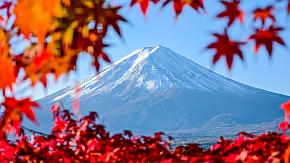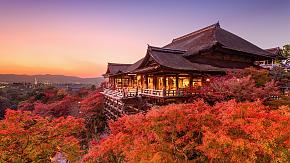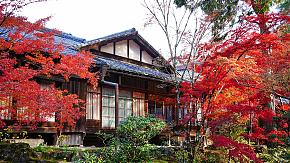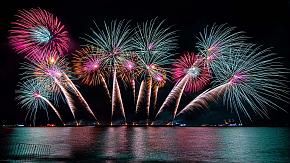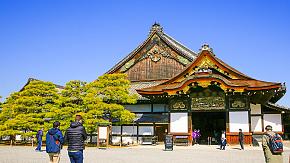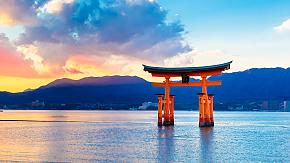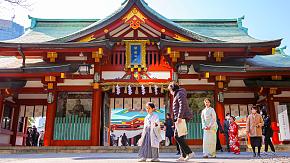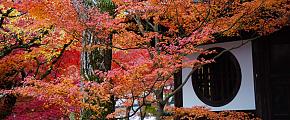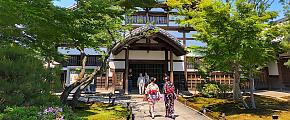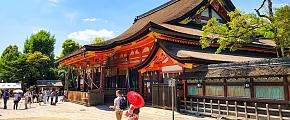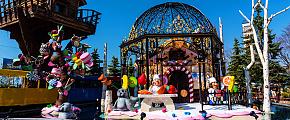Visit Japan in Fall: Weather & Best Autumn Leaf Spots 2026
With rolling hills and dense maple trees, Japan presents a variety of visual feasts to every visitor in fall. With the pleasant, cool weather, take in a riotous profusion of autumn leaves falling to the shrines and ground, where deer amble around at their leisure. A fall trip to Japan is like stumbling into a palette that is covered in thick layers of crimson and yellow colors. All the amazing views are collected here.
Japan's Weather in Fall
From September to November, Japan's weather in fall is at a pleasant temperature of 10 to 25℃, with sufficient sunshine and lower humidity, usually considered one of the best times to visit Japan.
It is comfortable enough for all kinds of outdoor activities to explore this charming land, whether for city sightseeing or embracing its stunning fall colors.
Visiting Japan in fall is an ideal time to avoid the summer heat and rainy season, however, some light coats to keep warm are still recommended for your night or early morning journey.
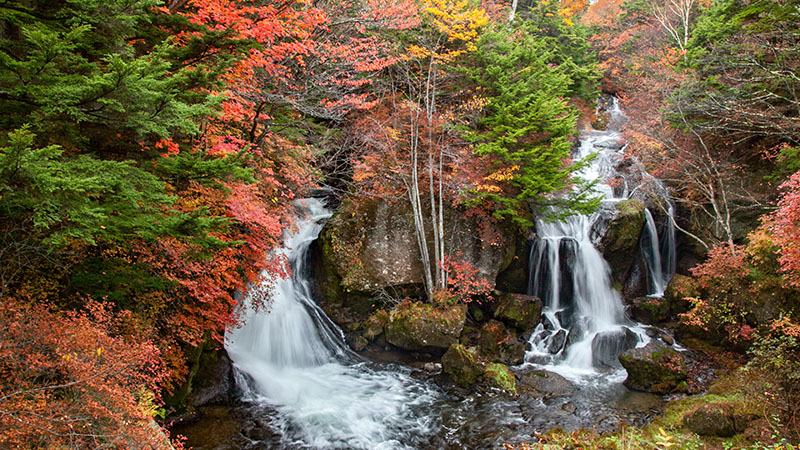
Cost & Crowds
Coinciding with the autumn leaves season, fall is also the peak travel season in Japan, when locals and overseas rush into fall foliage viewing - momijigari.
Though the prices for a fall visit can be relatively lower compared to the spring cherry blossom season, it is still common to catch higher prices and restrictions for flight tickets and hotel rooms during your autumn visit in Japan, especially from October to November.
Or, consider a September journey before the peak fall foliage season to take advantage of mild weather, fewer crowds, and affordable prices, when you can also capture Japan's fall colors in Hokkaido.
When to See Fall Colors in Japan
Mainly affected by the cool temperature, the earliest fall color appears in the higher latitude region, Hokkaido, which can start in mid-September. Central cities such as Kyoto, Nara, and Tokyo usually have their new yellow outfits from late October. November marks the final turn to deep red in Honshu, yet the warmer Kyushu may delay its stunning colors till December.
Based on last year's data from the Japan Meteorological Agency, below is the latest 2026 Japan autumn leaves forecast for your reference (it may be postponed due to the warm temperature).
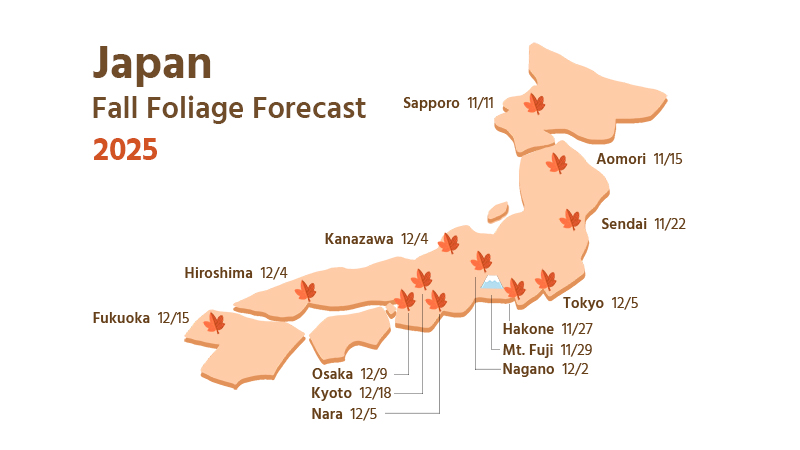 Japan Fall Foliage Forecast Map 2026
Japan Fall Foliage Forecast Map 2026
Best Places to Visit in Fall in Japan
Each city has its own special locations and highlights that match the stunning autumn leaves. Below are the best autumn destinations with their top fall foliage spots to enjoy the fall colors in Japan, from ancient cities with temples hidden behind colorful branches to mountains covered by dense red leaves.
Kiyomizu-dera Temple, Kyoto
Autumn is considered the best time to visit the Kiyomizu-dera Temple, Kyoto. Walking through the path adorned with fiery maple trees, you can see the ancient temple with its red walls, green tiles, and eaves carved with colorful red. The most beautiful view comes at night. The five-story pagoda on top, as well as other classical temples, has lit golden lanterns, which make the fiery leaves overflow with more glitter.
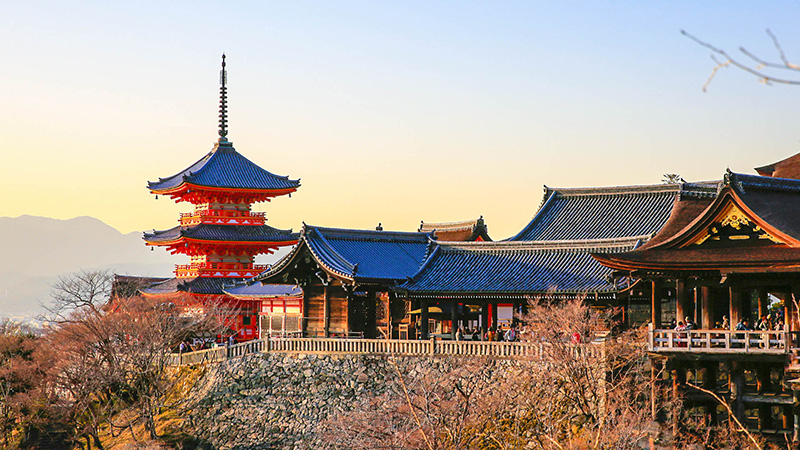 Kiyomizu-dera Temple
Kiyomizu-dera Temple
Meiji Shrine Outer Garden, Tokyo
Tokyo not only offers endless autumn leaves but also large scales of golden ginkgo. Meiji-jingu Gaien, you can see lines of towering golden ginkgos on the avenue, one side of which is trimmed to a straight upward shape, and the other side stretching out freely. You can also join the stroll on the crisp blanket with locals, where golden leaves shining under sunlight resemble a perfect setting from Japanese TV series.
Lake Kawaguchi, Mt. Fuji
Standing on the bank of Lake Kawaguchi, where sunlight falls on the red leaves above, bringing the enjoyable warmth of mid-autumn, you will embrace the pure Mt. Fuji merging into the azure horizon. On the other side lies a surprising flower land. The clusters of red bassia scoparia dance in the cool freeze before your eyes like little elves.
You can also find the nearby Maple Leaves Corridor with crimson foliage on both sides. The red branches intertwine above the corridor and naturally form a beautiful dome for its lively autumn leaves festival.
Nara Park, Nara
On a sunny autumn day, it's wonderful to ramble in the ancient temples and meet cute deer in Nara. You can drop by Kasuga Taisha, dotted with red leaves. There are many docile, beautiful deer with pointed ears, which are considered to be the messengers of God in Japan. Cookies specially made for deer are sold to people who want to feed these cute creatures. In the evening, the shrine will be lit up by the lanterns, emitting a red glow in the dark forests, and the paths will also be illuminated to welcome people coming for prayer.
Daisetsuzan National Park, Hokkaido
Located at the highest latitude in Japan, Hokkaido has Japan's earliest autumn. Daisetsuzan National Park is a natural forest park with a beautiful canyon lying in the center. In late September, the maple leaves here gradually turn yellow and red. You can take a cable car to go through the cliffs with trees that are wildly growing, and the gurgling sound of the brook echoes in the canyon. Finally, you reach the top, where you can look down to catch a panorama of the colorful leaves all over the mountain.
Top Things to Do in Japan's Autumn
Take a Leisure Kumano Kodo Hike
Kumano Kodo is one of the best hiking routes in Japan, especially in the autumn, when the paths and magnificent shrines are set against a backdrop of lush maple trees. It is a fascinating experience to follow the Nakahechi trail to sample the layers of Japanese autumn. Stroll the path of golden leaves to those shrines and pagoda hidden under the maple leaves, and even the pure white Nachi no Taki waterfall, decorated with the occasional maple leaf falling into the water, with a hint of autumn red.
Enjoy the Flavor of the Harvest Season
There is no shortage of authentic delicacies when visiting Japan in fall, with various flavors bustling in this harvest season. Matsutake mushrooms, one of the most iconic ingredients, add an earthy, spicy aroma to your moonlit evenings and autumn leaf viewing. The sweet smell of roasted chestnuts and sweet potatoes also fills the streets and parks, offering a treat always ready to warm your hand and heart. Or simply stop by the dessert stalls for a seasonal persimmon or pumpkin wagashi.
Relax at Hot Spring Onsen
Immersing yourself in the soothing warmth of an onsen is the perfect way to unwind after a day of autumn sightseeing. With the refreshing scent of pomelo and a hint of sulfur in the air, the hot spring not only wards off the evening chill but also rejuvenates your body and soul. For an authentic cultural experience, staying at a traditional ryokan with tatami beds is highly recommended - especially those with open-air hot springs, where you can soak under the moonlight or admire the floating autumn leaves.
More Tips for Japan's Autumn Leaves Season
Book in Early
Typically, early booking of around 6 months in advance is recommended for your ideal fall foliage season accommodation. For some popular fall colour destinations such as Kyoto, the ideal is 9 months in advance.
Dress in Layer
Blessed with plenty of sunshine, autumn in Japan is still warm enough to pack lightly. However, temperatures drop quickly after sunset, so a few light jackets will still be necessary for nighttime sightseeing, especially in Hokkaido or some of the mountainous areas on your autumn leaves itinerary.
Plan Your Colorful Autumn Japan Tour With Odynovo
With their awe and deep understanding of nature, Japanese people keep most of the colors and views here to retain their original beauty and connect them harmoniously with quaint architecture. In the beautiful autumn, walk through each picturesque view: the flaming maple forest, the solemn wooden temples, and the lovely deer. Are you motivated? Just contact us for a personalized Japan tour, and we'll take you to catch the rays of fresh vitality in the natural tranquility.
Related Posts You May Like
What Our Clients Say
Explore the latest verified reviews of Odynovo's travel services on Tripadvisor, Google, Trustpilot, Product Review and more trusted platforms.

